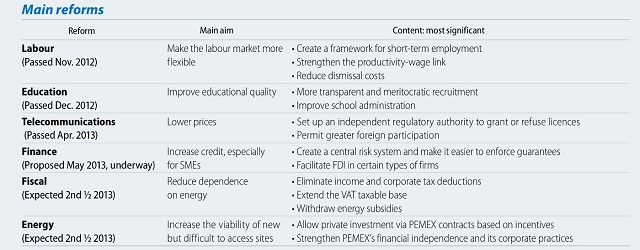Within an environment of macroeconomic stability, Mexico has undertaken a programme of structural reforms that will be key to boost the country’s potential growth. Most analysts believe this potential could go from the current figure of 3.5% to 5%-6% if this battery of reforms is fully implemented.
The political consensus required to bring this ambitious programme to fruition was formalized at the end of 2012 with the signing of the «Pact for Mexico» by the PRI, the PAN and the PRD (the three political parties that represent 86% of the lower house). The main lines of reform included in this Pact are: labour, education, telecommunications, finance, energy and the fiscal area. The first three have already been approved by Congress, financial reform is currently underway and the proposed fiscal and energy reforms are expected to be presented during the second half of this year (see the table summarizing the reforms).
The labour reform, the first to be approved and already being implemented, broke with 40 years of immobility in labour structures, introducing measures that reinforce the link between productivity and wages and new types of contracts that allow shorter term relations and reduce dismissal costs. All this aims to make the labour market more flexible.
Regarding educational reform, the main modification consists of establishing a meritocratic system for teaching posts, eliminating the customary practice of inheriting or even selling such positions. Undoubtedly an improved system of incentives is essential in order to improve educational quality and, ultimately, long-term economic growth. For its part, the reform of the telecommunications industry plans to encourage competition with the main aim of reducing prices that are deemed to be too high. Among others, it includes the liberalization of foreign investment in this sector.
Promoting credit and making loans cheaper, especially for SMEs, is the main aim of the proposed reform of the financial sector presented at the beginning of May. In Mexico, bank loans to private industry account for less than 50% of the sector’s assets compared with figures of around 95% in countries such as Chile and Peru. Increasing competition, encouraging development bank lending (state banks) and improving the system of guarantees are some of the actions proposed by this reform.
Lastly, the complex fiscal and energy proposals are expected to be presented in the second half of 2013, both closely related to the country’s strong dependence on public oil revenues (one third). Together with the labour reforms, most analysts attribute the largest part (two thirds) of the expected boost provided for potential growth to these two reforms.
In order to be effective, both pending reforms should tackle three key issues: firstly, permit private investment via PEMEX contracts (the state energy firm) and thereby facilitate the exploitation of sites such as deepwater locations, which contain significant oil reserves; secondly, restructure PEMEX to improve its efficiency in terms of processes; and thridly, make public revenue less dependent on oil, such as by eliminating income tax deductions.
In short, Mexico has really taken on board the saying that, in order to grow, you need to reform. And, for the moment, it has not hesitated in putting this into practice.






Be the first to comment on "Mexico must cut oil dependency"